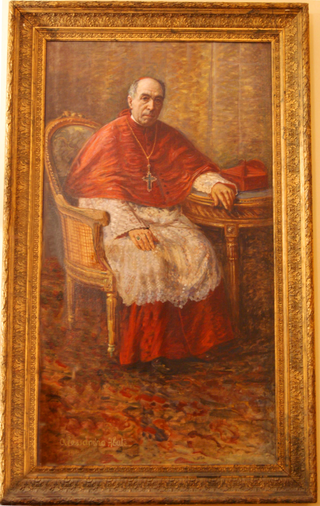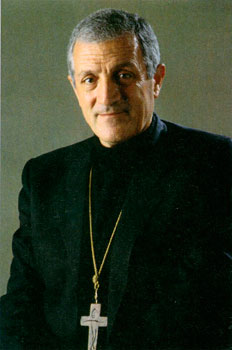
Józef Bilczewski was a Polish Roman Catholic prelate who served as the Archbishop of Lviv from 1900 until his death. He served as a theological and dogmatics professor in the Lviv college after himself having earned two doctorates in the course of his own studies. He earned a reputation as a learned and cultured man; these qualities led to Emperor Franz Joseph I nominating him for the Lviv archdiocese as its head. Pope Leo XIII named him as its archbishop and he set to work prioritizing a range of different pastoral initiatives aimed at revitalizing the faith within people and also prioritizing ecumenical cooperation with other denominations.

Ciriaco María Sancha y Hervás was a Spanish cardinal of the Catholic Church who served as the Archbishop of Toledo in addition to being the Primate of Spain and the Patriarch of the West Indies. He established what is now known as Sisters of Charity of Cardinal Sancha in 1869.

Giuseppe Francica-Nava de Bontifè was an Italian Cardinal of the Catholic Church who served as Archbishop of Catania from 1895 until his death; he was elevated to the cardinalate in 1899.

Franz Josef Rudigier was an Austrian Roman Catholic prelate and served as the Bishop of Linz from his appointment in 1853 until his death. Much of his local diocese grew due to his vigorous in promoting evangelic zeal and fundamental religious principles. He became the intellectual figurehead for Catholics in their struggle with liberalism. He promoted the Christian press and took a visible stand defending the 1855 concordat, when liberals annulled it without papal consultation in 1870. A beatification process for Rudigier was initiated under Pope Pius X in 1905 and he was titled as a Servant of God. The confirmation of his life of heroic virtue allowed for Pope Benedict XVI to name him as Venerable in 2009.

Tommaso Reggio was an Italian Roman Catholic prelate who served as the Archbishop of Genoa from 1892 until his death. He was also the founder of the Sisters of Saint Martha. Reggio distinguished himself during an earthquake that struck his diocese in 1887. He tended to the injured in the rubble and led initiatives to direct diocesan resources towards the displaced and the injured; while in Genoa he collaborated with Bishop Giovanni Battista Scalabrini in tending to immigrants through a range of different pastoral initiatives.

Miguel Ángel Builes Gómez was a Colombian Roman Catholic prelate who served as the Bishop of Santa Rosa de Osos from 1924 until his death. He was the founder of the Xaverian Missionaries of Yarumal (1927) and the Missionaries of Saint Thérèse (1929) as well as the Contemplative Sisters of the Blessed Sacrament (1939) and the Daughters of Our Lady of Mercy (1951). Builes was a prolific writer of pastoral letters and he condemned a vast range of issues in Colombian life that he deemed to be either too liberal or in breach of traditional doctrine; among those he condemned were women wearing trousers and various dance forms. He was a staunch defender of the faith which made him a controversial figure in his diocese with those praising and condemning him for his activism; but there were those who praised his orthodox views and his defense of doctrine in the face of a wave of secularism.

Giuseppe Benedetto Dusmet – born Giuseppe Dusmet – was an Italian Roman Catholic cardinal who served as the Archbishop of Catania from 1867 until his death. He became professed into the Order of Saint Benedict where he took "Benedetto" as his religious name. He studied under the Benedictines prior to joining them before serving as a professor in addition to prior and abbot. His elevation to the episcopate saw him distinguish himself in cholera epidemics when he tended to the ill while also remaining a strong advocate for the poor of his archdiocese. He remained a Benedictine and was known to continue to don the Benedictine habit instead of the red cardinal's regalia.

Giuseppe Guarino was an Italian Roman Catholic prelate and cardinal who served as the Archbishop of Messina from 1875 until his death. He was also the founder of the Apostoli della Sacra Famiglia. Guarino dedicated himself to proper religious formation for both priests and nuns while serving in both Siracusa and Messina and was known for reigniting the faith in those who were considered cut off from the faith.
Giuseppe Carraro was an Italian Roman Catholic prelate who served as the Bishop of Verona from 1958 until his retirement in 1978. He also served as the Bishop of Vittorio Veneto until his transferral to the see of Verona.
Maximiano Valdés Subercaseaux - in religious Francisco - was a Chilean Roman Catholic prelate who was a professed member from the Order of Friars Minor Capuchin and served as the first Bishop of Osorno from 1956 until his death. Valdés discerned his call to the priesthood while with his parents in Europe and was ordained as a priest in Venice after completing his studies in Rome but continued further formation amongst the Franciscans in Europe before making his return to Chile. He was the first Chilean to have become a Capuchin friar. Valdés dedicated his episcopal career to the poor and he often visited the poor regions around his diocese while remaining a staunch advocate for a peaceful resolution to the Chile-Argentina border disputes; his last words also contained a desire for there to be peace between the two feuding nations.

Antonio Bello was an Italian Catholic prelate who served as the Bishop of Molfetta-Ruvo-Giovinazzo-Terlizzi from 1982 until his death from cancer in 1993. Bello studied in various colleges and seminaries in places such as Bologna and Rome before being named to several positions in his region where he served as a priest. He was later made a bishop and became known for his eloquent teaching and for his pastoral sensitivities while being noted for his emphasis on greater diocesan participation on the part of the faithful. Bello also was a member of the Secular Franciscan Order and was a vocal critic of international conflicts such as the Gulf War.
Augusto Bertazzoni was an Italian Roman Catholic prelate who served as the Bishop of Potenza from 1930 until his retirement in 1966. He was titled later in his career as an archbishop despite running a normal diocese as opposed to archdiocese; upon his resignation he was given a ceremonial position which he occupied until his death.
Salvatore Micalizzi was an Italian Roman Catholic priest and a professed member of the Congregation of the Mission in his desire to follow the footsteps of Saint Vincent de Paul. Micalizzi served as a preacher and became a well-known evangelizer in Naples.

Giovanni Schiavo was an Italian Roman Catholic priest and a professed member from the Congregation of Saint Joseph – otherwise known as the Murialdines. Schiavo entered the Murialdines during World War I in 1917 where Eugenio Reffo allowed him to join and he was later ordained to the priesthood in Vicenza in 1927 a decade later. His superiors allowed him to join the missions – to spread the charism of the Murialdines – in Brazil where he served from 1931 until his death several decades after.

Arsenio da Trigolo, OFM Cap., was an Italian Catholic priest and a professed member from the Order of Friars Minor Capuchin.
Francesco Saverio Toppi - born Vincenzo Toppi - was an Italian Capuchin who served as the Prelate of Pompei from 1990 until his resignation in 2001. Toppi fostered a deep devotion to the Blessed Mother and this devotion further developed and was solidified when he was appointed to oversee the Marian shrine in the Pompei prelature. He carried out his duties to the fullest as a teacher serving in Palermo and Naples prior to his episcopal appointment and served in various capacities of leadership for his order.

Antonio Augusto Intreccialagli - in religious Antonio di Gesù - was an Italian Roman Catholic prelate and professed member from the Discalced Carmelites who served as the Archbishop of Monreale from 1919 until his death. Intreccialagli served prior to this as the coadjutor for the archdiocese and before that served as the Bishop of Caltanissetta when he was nominated to the episcopate. He was also the co-founder of the Oblates to the Divine Love which he established alongside the Servant of God Margherita Diomira Crispi.

Jan Pietraszko was a Polish Roman Catholic bishop who served as one of the auxiliaries for the Kraków archdiocese and Titular Bishop of Turrisblanda from 1962 until his death. Pietraszko was a noted spiritual director and chaplain as well as a popular confessor but was best known for his sermons and for his homiletic writings. He did his ecclesial studies just before World War II broke out and was a brief hostage of the Gestapo after the Nazi forces invaded Poland in 1939. He later came under the watch of the communist secret service following the conflict for his attempt to see new churches constructed and church art and architecture preserved.
Giovanni Battista Pinardi was an Italian Roman Catholic prelate who served as a bishop in Turin serving under three archbishops for the archdiocese. Pinardi studied for the priesthood in Chiari before his ordination in 1903 and served as a pastor until his episcopal appointment in 1916. He collaborated with Catholic Action and served as the vicar-general for the archdiocese from 1924 until Cardinal Maurilio Fossati removed him from the position in 1931 upon the advice of Pope Pius XI. His demotion enabled him to dedicate more time to his pastoral duties in the San Secondo parish church where he served from 1912 until his death. Pinardi tended to the displaced during World War II after a series of bombings in his region and was known for his anti-fascist views which contributed to his demotion from the vicar-general position.
Vincenzo Lipani - in religious Angelico - was an Italian Roman Catholic priest and a professed member from the Order of Friars Minor Capuchin who founded the Franciscan Sisters of the Lord. Lipani settled on the religious life but later joined the Franciscans after his parents relented; he did his religious formation as well as his theological and philosophical studies in Palermo where he was ordained in 1865. But new legislation forced religious orders to dissolve and he instead began to serve as a teacher in Caltanissetta for over two decades before being given a parish church to renovate and act from. He later was able to help restore his order in the region and founded a religious congregation dedicated to tending to the poor.













